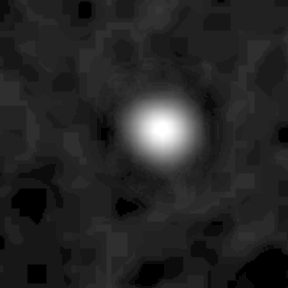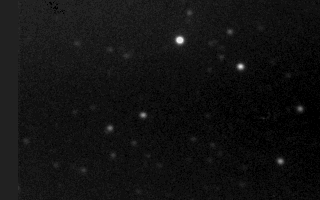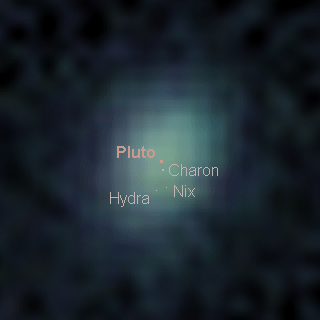
| Description: Tiny Pluto is imaged here, although it cannot be well-resolved with our
telescopes. In this magnified image, Pluto and Charon are seperated by around 9 pixels, Pluto has an
angular diameter of around 1 pixel and Charon of about half a pixel. Charon may be to the upper-left
of Pluto on this image, but that might just be wishful thinking.
Image information: 20 x 15s unfiltered images taken 28/06/2006.
Image has undergone an unsharp mask and 8x magnification to improve clarity.
Physical information: See below
|

| Description: See Pluto moving over the course of three nights in these images. This is how Pluto was originally found - by comparing photographic plates and observing its motion. The width of this image is about 1/8 the width of the Moon. (The star in the bottom left isn't really getting brighter, it was just out of shot in the first image).
Image information: 20 x 15s unfiltered images taken 28th, 29th, 30th June 2006.
Physical information: magnitude 13.9, diameter 0.14", phase 100%, distance: 30.15 AU.
|

| Description: Here's Pluto in context, in a false-colour (V, R & I band) image. You could be forgiven for missing it - it's the greeny-blue dot in the centre. Pluto's colour is actually orangey-red, while its largest satellite, Charon (not resolved here), is more of a grey colour.
Image information: 15 x 10s unfiltered images, plus 20 x 10s R- and I-band images, plus 30 x 10s V images, reduced and colour-combined using AIP4Win, taken 08/06/2006.
|

| Description: An annotated 16x magnitifcation of the above image, showing the position of the planet and its three (known) moons. From this image, it's pretty clear why Charon wasn't discovered until 1978, while the other two moons, only around 100 km across, weren't discovered until 2005.
Image information: As above. Image has undergone 16x magnification to improve clarity.
|



